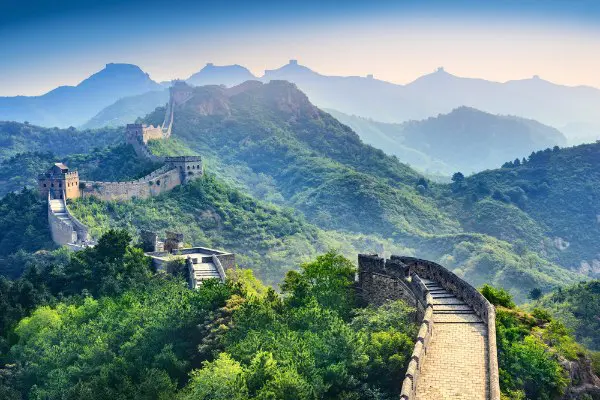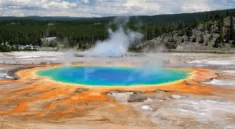
Winding its way through jagged mountains, sweeping valleys, and lush forests, the Great Wall of China is more than just a man-made structure—it is a monumental legacy of ancient ambition, perseverance, and engineering brilliance. Built over several dynasties and stretching more than 21,000 kilometers, the Great Wall is not just one wall, but a vast system of fortifications designed to protect the Chinese empire from invaders. Today, it stands as one of the Seven Wonders of the Medieval World and a UNESCO World Heritage Site.
Hiking along the Great Wall is an immersive experience that combines physical adventure with profound historical insight. Whether you’re tracing the stone paths of Mutianyu, exploring the grandeur of Badaling, or venturing to more remote stretches like Jiankou or Simatai, every step reveals echoes of the past and awe-inspiring natural beauty.
A Wall Built Through Dynasties
The Great Wall’s origins date back more than 2,000 years, to the 7th century BCE, when feudal states built defensive walls to protect their territories. These early walls were eventually connected and expanded by Qin Shi Huang, the first emperor of a unified China, around 221 BCE. However, most of the wall that remains today was rebuilt during the Ming Dynasty (1368–1644), using bricks, stone, and tiles, transforming it from simple earthen ramparts into formidable fortifications.
The purpose of the wall was multifaceted: to deter invasions, control immigration and trade, facilitate communication, and project imperial power. Towers, barracks, and garrison stations were built at intervals to house soldiers and signal dangers using smoke, fire, or flags. Over the centuries, the Wall became a living organism—constantly rebuilt, expanded, and defended.
A Symbol of Chinese Civilization
To hike the Great Wall is to witness the ingenuity, labor, and sacrifice of millions of workers—soldiers, peasants, prisoners, and artisans—who labored under extreme conditions to create what became the largest military structure in history. It is also to stand face to face with a structure that defines not just physical space, but also cultural identity. The Wall has become a symbol of Chinese endurance, unity, and pride.
The Mutianyu Section: Nature and Restoration in Harmony
One of the best-preserved and most accessible sections of the Wall is Mutianyu, located approximately 70 kilometers northeast of Beijing. It is a favorite among families, casual hikers, and history lovers due to its:
- Restored architecture: The section is extensively renovated but retains its authentic feel.
- Scenic beauty: Surrounded by dense woods and orchards, Mutianyu offers stunning views year-round, especially in spring blossoms and autumn foliage.
- Ease of access: With modern facilities, cable cars, chairlifts, and a toboggan ride down, visitors of all ages can enjoy this section.
Mutianyu features 23 watchtowers, with stone steps and paved paths varying in gradient, giving hikers the chance to explore its winding spine across ridges and dips. You can walk the wall for several kilometers, encountering dramatic vantage points, steep climbs, and historic detail in every tower.
The Badaling Section: Grandeur and Accessibility
If you’re visiting the Wall for the first time or seeking a more iconic experience, Badaling is the most famous and most visited section. Just 60 kilometers from Beijing, this portion:
- Was the first section opened to tourists in 1957.
- Hosted prominent figures like Richard Nixon, Margaret Thatcher, and countless world leaders.
- Is fully restored with wide walkways and handrails, making it ideal for large groups and less experienced hikers.
Despite being crowded at peak times, Badaling still delivers unforgettable moments. The steep inclines challenge even seasoned hikers, while the panoramic views from the watchtowers showcase the strategic brilliance of the original builders. From here, the wall stretches toward the horizon like a coiling dragon—serene yet commanding.
Jiankou: Wild, Steep, And Breathtaking
For thrill-seekers and experienced hikers, Jiankou is often considered the most dramatic and rugged stretch. Unrestored and wild, Jiankou offers:
- Jagged ridgelines and near-vertical stairs.
- Ancient, crumbling towers and unrestored pathways.
- Intense but rewarding physical challenge.
Located northwest of Mutianyu, Jiankou is known for its photographic beauty, especially during sunrise or misty mornings. It’s not suitable for beginners, and safety precautions are essential—but the reward is a glimpse into the untamed heart of the Wall.
Many hikers choose to do a “Jiankou to Mutianyu” trek, which starts in the wild section and ends in the restored one—providing the best of both worlds.
Simatai: A Wall That Lights Up The Night
For an unforgettable experience, Simatai offers night tours, allowing visitors to see the Great Wall illuminated under the stars. Unlike other sections, Simatai retains its original Ming architecture and features:
- Steep ascents and dramatic views of reservoirs below.
- Open at night, offering a rare after-dark perspective.
- A blend of restored and original structures, showing the transition of preservation.
Nearby, Gubei Water Town, a recreated ancient village, provides a scenic base with boutique hotels, shops, and restaurants. It’s ideal for travelers wanting to combine culture, comfort, and exploration.
Hiking Tips and Preparations
Hiking the Great Wall requires some preparation, especially for longer treks or less-developed sections. Here are essential tips:
1. Wear Appropriate Footwear
Good hiking shoes are essential. The Wall includes steep inclines, uneven surfaces, and stone steps that can become slippery in rain or snow.
2. Hydration and Snacks
Bring plenty of water, especially in summer. Some sections have vendors or cafes, but in remote areas, you must be self-sufficient.
3. Dress in Layers
Weather can change rapidly, especially in mountain regions. Dress in moisture-wicking layers and bring a windbreaker.
4. Watch the Weather
Fog or rain can obstruct views and make hiking dangerous. Check forecasts before you go and avoid remote areas in bad weather.
5. Respect the Site
Do not remove stones, graffiti, or climb on dangerous parts of the Wall. It’s a cultural treasure that needs preservation.
Historical Insights Along the Way
As you hike, you’ll encounter signs, plaques, and guides offering insights into the Wall’s strategic importance, construction techniques, and military history. You’ll learn how:
- Smoke signals were used to communicate enemy sightings.
- Watchtowers served as lookout points, storage, and living quarters.
- Wall sections varied in material and design based on geography.
You might imagine the life of a Ming Dynasty soldier stationed there—enduring harsh winters, surviving on sparse rations, and keeping vigil for signs of attack. These human stories are what bring the Wall’s stones to life.
Cultural Significance and Modern Symbolism
Today, the Great Wall is more than just a tourist attraction. It represents national pride, resilience, and the unifying spirit of China. It has inspired poets, artists, and thinkers for generations. A common Chinese saying—”He who has not climbed the Great Wall is not a true man”—illustrates the cultural importance of this feat.
The Wall also continues to play a role in geopolitics, heritage debates, and environmental concerns. Restoration projects must balance tourism with authenticity, and conservation efforts focus on erosion prevention, wildlife protection, and climate resilience.
Best Time To Visit
The Wall is open year-round, but the best months to visit are:
- Spring (April–May): Mild temperatures, blooming flowers.
- Autumn (September–October): Crisp air, colorful foliage.
- Avoid summer crowds and intense heat unless you’re prepared.
Getting There
From Beijing, the Wall is easily accessible by car, bus, or train:
- Mutianyu: 1.5–2 hours by car or via shuttle tours.
- Badaling: Reachable by bullet train, local buses, or taxis.
- Jiankou and Simatai: Require more planning, often involving local transport and longer hikes.
Many hotels in Beijing offer guided day trips, and private drivers are a convenient option for custom itineraries.
Conclusion: A Walk Through Time
Hiking the Great Wall of China is not just a physical journey, but a time-traveling expedition through the heart of one of the world’s oldest civilizations. From the restored battlements of Badaling to the wild peaks of Jiankou, every stone tells a story, every tower holds a secret, and every view stirs the soul.
Whether you come for the adventure, the history, or the sheer majesty of the landscapes, the Great Wall never fails to move, to inspire, and to humble. It’s a journey that stays with you long after your feet have left its ancient stones—a hike not only across terrain but across time itself.
If you’d like a Bahasa Indonesia version, infographic layout, or itinerary suggestions based on this article, feel free to ask!



